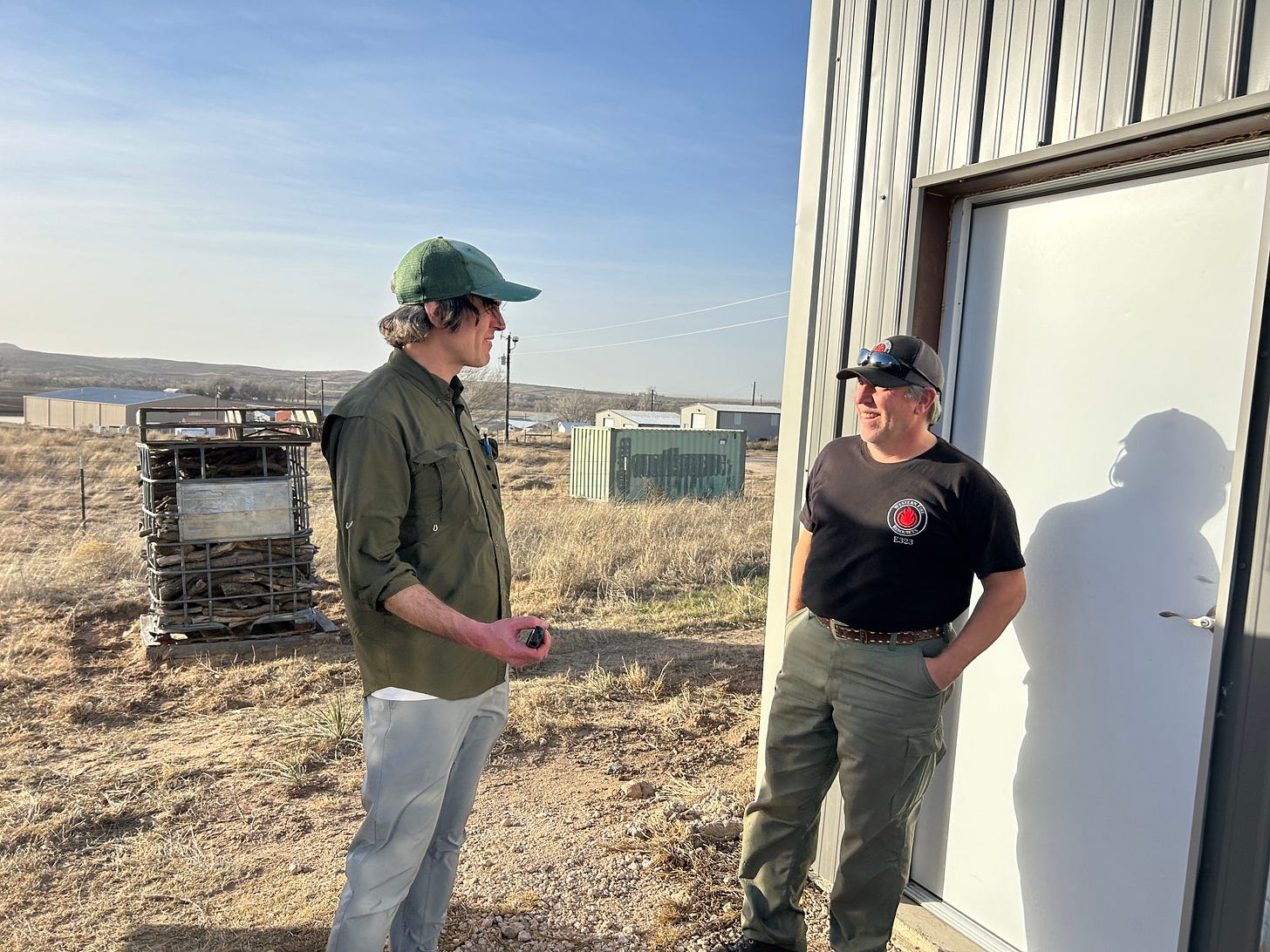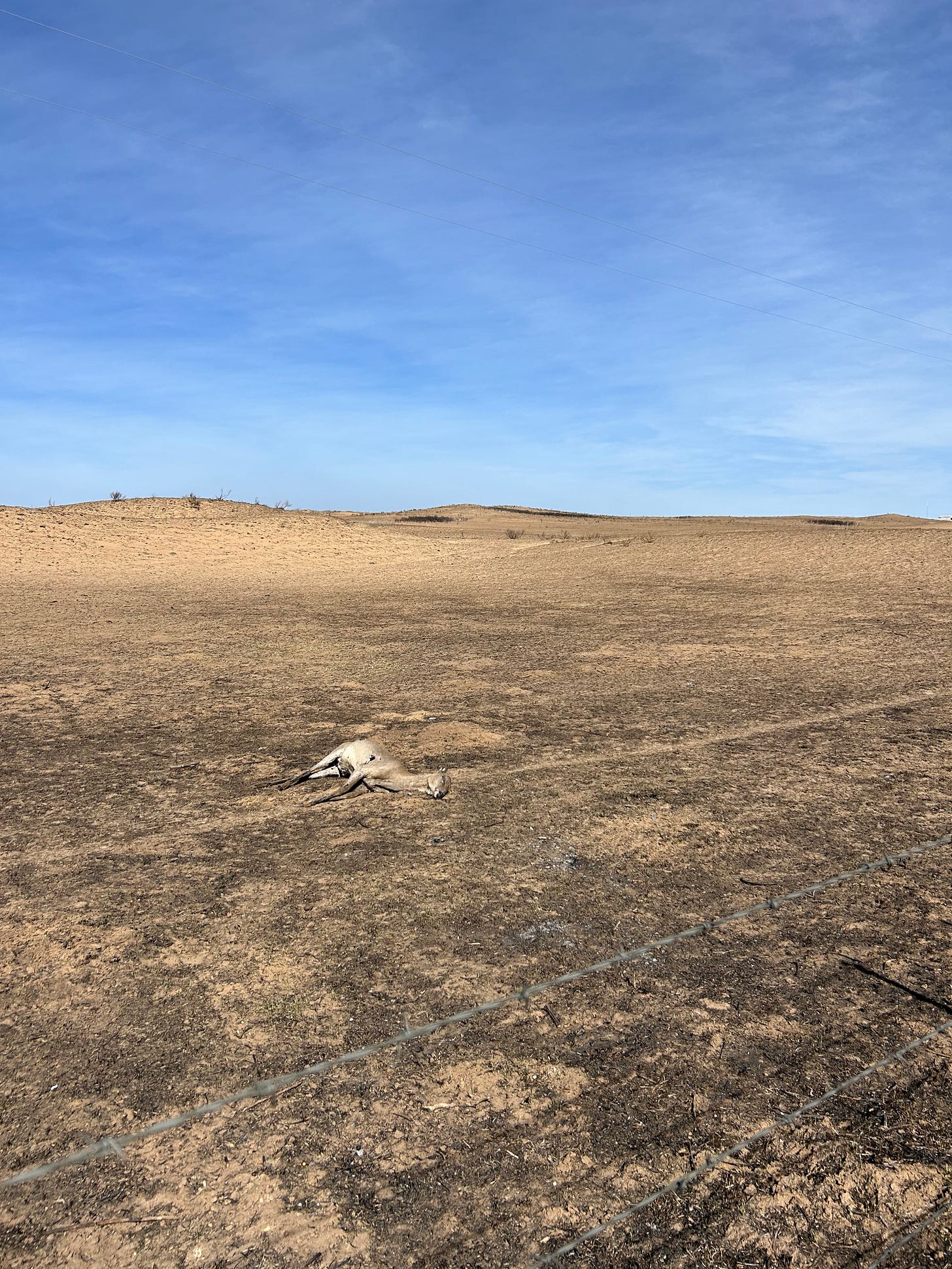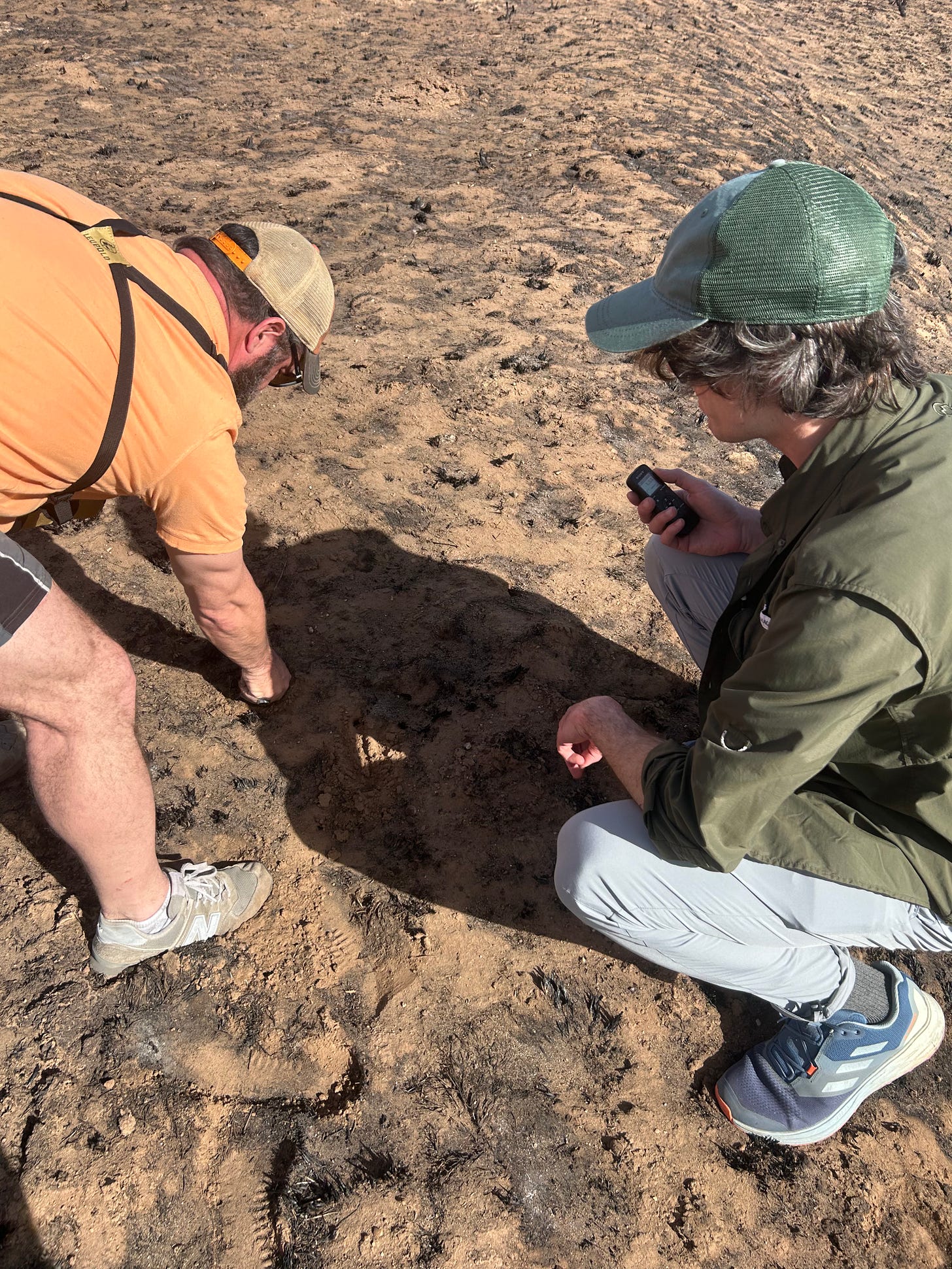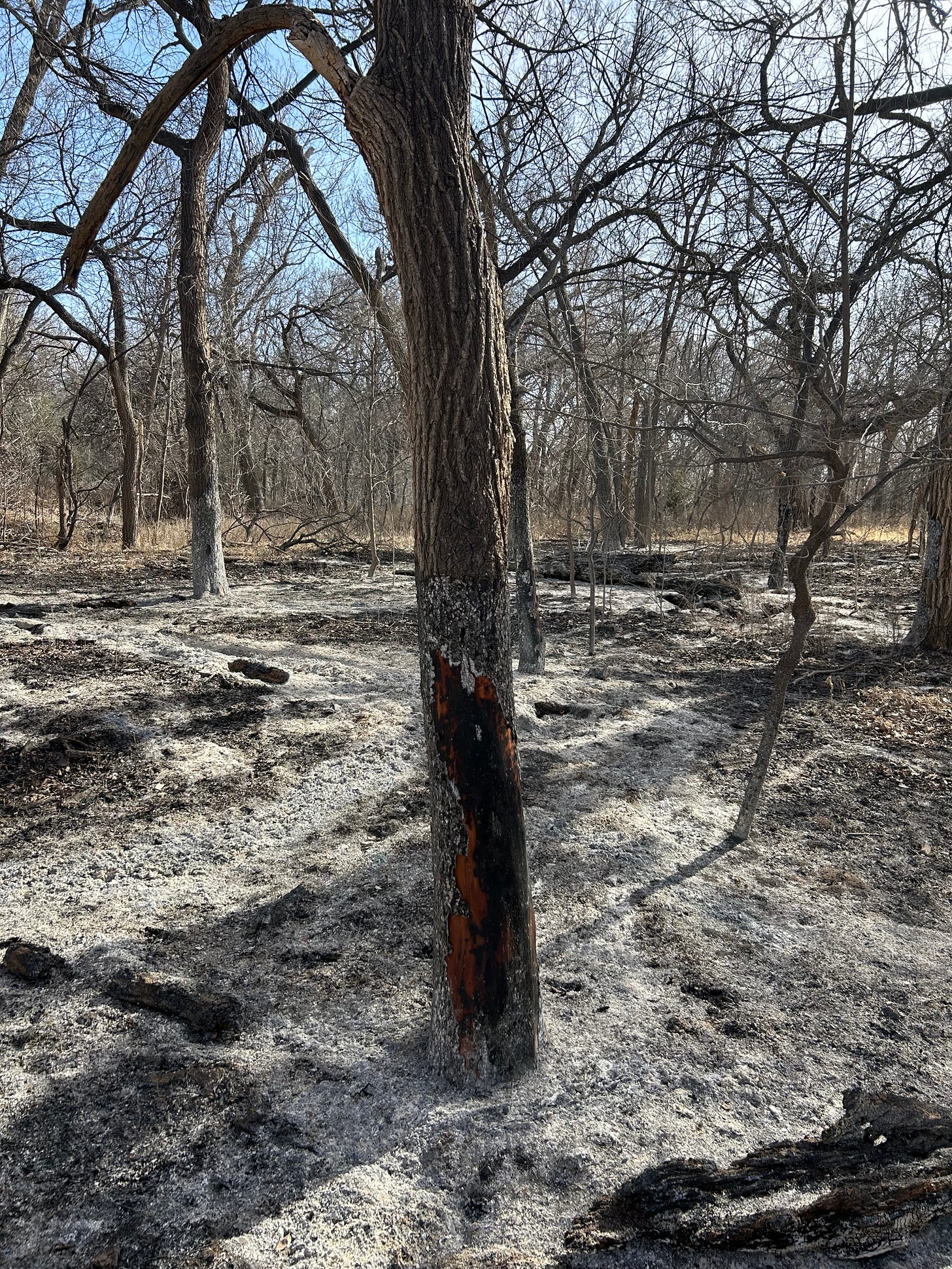I drove to Texas on March 3 to learn about the Smokehouse Creek Fire—one of the largest wildfires in modern U.S. history.
In Canadian, a Panhandle city with some 2,200 residents, I met with:
Jamie Baker, a wildlife biologist and wildland firefighter;
Beto Guillen, a wildlife photographer; and
Derrick Holdstock, a wildlife biologist and the owner of Western Fire Resources.
And on March 7, I called Trey Bates, an Amarillo business owner. He coordinates relief efforts, and runs supplies, across the Panhandle.
Their stories are here, intertwined as an oral history. Molly Ross took all the photographs but the last, which is Beto Guillen’s.
Wednesday, February 14
Beto Guillen: Two weeks before the fire happened, I had a dream where there was a fire: houses were on fire, and I couldn’t evacuate; it was already too late. I think it’s a sign.
Monday, February 26
Derrick Holdstock: The fire started on Monday, in Stinnett. We’re seeing this big column. So I started doing a little bit of research on it. I saw that it had made about a 40-mile push from Stinnett—it was 16 miles outside of town.
Jamie Baker: The fire progressed from west to east, along with the prevailing winds.
Beto Guillen: They said, If the fire doesn’t get here tonight, it’s gonna get here tomorrow.
Derrick Holdstock: And so immediately, we’re thinking, O.K. It is coming to town in the morning.
Tuesday, February 27
Jamie Baker: I noticed a wind shift and a change in wind intensity. And I noticed what’s called a pyrocumulus go up—it’s when a fire makes so much heat that it makes its own cloud system temporarily. I took a picture of it, and I said, Hey Derrick, did you see that pyrocumulus? He’s like, Yeah, I’m tracking it.
Derrick Holdstock: I grabbed Jamie, and we went around town around 11:30 A.M. and did what we call structure triage. We’d look at each structure and decide, That one would stand alone without any help. This would be defendable. This is a death trap. We didn’t know which flank would hit town first, but we had a plan going. And it turned out the south flank hit first.
Trey Bates: I was in Amarillo when this here happened. I was taking a nap—I woke up, and seen it. And within an hour I was headed to Sam’s Club. I had my live videos going; I had poached out where I was going to be. Donations started pouring in. Within two hours, I had two pallets of water bought, a bunch of other supplies. And me and another guy, my son, and his girlfriend headed towards Pampa.
Beto Guillen: I evacuated Tuesday, around 2:20 P.M.
Trey Bates: That’s when the big fire over by Canadian—the Smokehouse Fire—went huge.
Derrick Holdstock: By 2:22 P.M., the first flames were visible south of our shop on Isaacs Ranch Road.
Beto Guillen: People left at the very last minute, but it was pretty well-coordinated. I followed my mom and sister; my brother’s a volunteer firefighter. When I first left, there was a line from the Best Western Hotel all the way to the football field. I was with my two dogs. They were yelping, ‘cause I guess they were scared. It was wild going out of town, because it was bumper-to-bumper the whole way.
Trey Bates: We wanted to go to Canadian, and we couldn’t get through—because the fire was jumping Route 60 at that time.
Derrick Holdstock: They had the roads going north and south closed.
Jamie Baker: The fire did an envelopment maneuver around the whole town.
Derrick Holdstock: So there really wasn’t any access to get in. Our Amarillo firefighters reported at 2:44 P.M. They were stopped south of the fire, as it flanked and eventually made a run in their direction.
Trey Bates: They diverted us over to McLean.
Beto Guillen: We went to Wheeler, Texas. They had a shelter.
Jamie Baker: We went down the first road, which was Hackberry Trail. A lady named Sharon Carr flags us down, sends us up to her house.
Beto Guillen: There was maybe 50 or 100 people still trapped in town.
Jamie Baker: That’s when we get into our first engagement. At this point, we are not even deployed. We’re not getting paid for it. We’re just two of the most qualified wildland firefighters in this town, and we’re going to go out and help.
Derrick Holdstock: Jamie and I went and protected—you can kind of see the house on the hill over here. Protection was completed by 3:19 P.M.
Jamie Baker: From there, we went and started finding more houses on the western side of town. We actually did one down at the Red Deer Overpass; it’s close to the BNSF railroad tracks.
Derrick Holdstock: We set up a sprinkler kit there at 4:29 P.M.—these are high-pressure sprinklers you can run off these engines, they’re not your regular garden sprinkler. We pumped the sprinklers for several minutes, but then the wind shift from the north hit. Jamie was the one that saw the fire first. He said, It’s go time.
Jamie Baker: We did have to make a hasty retreat out of there, because the flames were so intense, and so encompassing.
Derrick Holdstock: We disconnected the hose and sprinklers, pulled out to the road, and the fire moved through the property. We returned after to assess the structure—which was saved. And we rescued a small dog from the rear of the residence.
Jamie Baker: That’s basically what we did all around the town that day. From beginning to end, everybody was on a fire footing.
Derrick Holdstock: We don’t generally work in Texas. Texas has a policy not to use contractors.1 The only reason we were involved in this one is I made us available to the county judge.
Jamie Baker: I’ve been a firefighter for 24 years—an NWCG-certified wildland firefighter. I’ve been on wildfires before, as well as prescribed fires. And this one—with the wind speed—
Derrick Holdstock: The wind was 40, gusting to 55 all day. So it was pretty nasty all day.
Jamie Baker: —the heat, the intensity, the fuel, my proximity to the actual flame fronts—and actually getting hit in the face with flame—and having my beard singed—and the wall of smoke and ash that was so persistent and inescapable, it was overwhelming.
Derrick Holdstock: Out here, where there’s just so much dust and sand, it’s strange: you don’t see the fire until it’s probably about 60 yards from you. The best way that we could tell the fire was close is when you looked up: you saw the column, but you also saw smoke underneath the column. When you knew that lower-level smoke was traveling that fast, you knew the fire was close.
Jamie Baker: The caustic feeling of that acrid smoke in your lungs is just indescribable. Not only is it acrid, it’s also hot. And the wind was blowing so fast, with a lot of lofted ash and particulate matter, that I became extremely overwhelmed, overcome—and this is a common thing on fires like this: I vomited. It was the intensity of that engagement, if I can put it in combat terms. I’ve been in combat before, and I’ve been through the engagement where your stomach drops, and your heart goes in your throat, and you know there’s a very real possibility you’re going to die. In this particular engagement, I didn’t even have time to think about that—it came on so quickly. But the feeling was still there. It was so amazingly terrifying.
Trey Bates: In McLean, them guys—we caught them over there at the gas station—were like, We’re good right now. He says, Wheeler’s getting their butt kicked. He says, Get it over to Wheeler.
Beto Guillen: We had to evacuate Wheeler around 6:00 P.M.
Trey Bates: When we pulled into Wheeler, we found the fire station. They didn’t have any supplies, hardly at all, and maybe five cases of water. We dumped our whole load right there.
Beto Guillen: I got to Childress around 9.30 P.M. I stayed the night there—another shelter, they had Army beds. It was mainly people from Canadian. I couldn’t sleep.
Aftermath
Trey Bates: We live here in the Panhandle of Texas. We don’t get a lot of rain. We’re always dealing with wind—high winds at that—dry locations. Fire is always a risk that is going to be out there. It’s always on your mind.
Derrick Holdstock: It’s a phenomenon that has always been around. But what hasn’t always been around is so many people; the Native Americans knew not to light a fire on a day like that. There’s so many people, and there’s so many things that could happen. You could have something totally accidental—like a blown tire, and your rim sparks. It only takes a small spark on a day like that.
Jamie Baker: The prevailing consensus—that wildfires are getting worse because of anthropogenesis2—I’ve got to push back on that. Because the science is such crap. The base argument is false in the first place. What we have to do, if we don’t want to have destructive situations like this, is we got to get out in front of it. We have to be aggressive with our prescribed fire3—get out in front of it, and prevent things like this from happening.
Derrick Holdstock: The prescribed fire we did in November stopped the Windy Deuce Fire before it ran into Borger, Texas. It did exactly what it was designed to do.
Jamie Baker: I think this is going to be one of those cathartic, significant moments where people are like, Maybe we need to look at how we’re doing things. And then change that.
Derrick Holdstock: Obviously, houses were lost.
Beto Guillen: A bunch of farm acres burned.
Jamie Baker: I’ve seen about 45 houses lost.
Derrick Holdstock: But we did save a couple. We did what we could.
Beto Guillen: Most ranchers have houses that they’re gonna let the people stay in. And then we have apartments, too, down by the pavilion.
Derrick Holdstock: Now, the fire’s like 100 miles long, and 35-or-something miles wide.
Beto Guillen: It’s bigger than Rhode Island. I saw a TikTok video of that.
Derrick Holdstock: You’re not putting something like that out.
Beto Guillen: I’m pretty sure everyone’s traumatized. My mom’s still a little bit traumatized.
Trey Bates: Being a rancher—it’s a hard life to live. You don’t make a lot of money. And when all this hits, you really got to jump in there and try to help.
Beto Guillen: There’s been support from other communities—from Amarillo—
Trey Bates: We ended up delivering three pallets of water to Canadian, with a ton of supplies.
Beto Guillen: —Pampa, even Gunter, Texas—farm supplies and stuff, and then supplies for the families that lost their homes: clothing, toothbrushes.
Jamie Baker: For this part of the world, a response like that—I would expect that of these people. Because if you look at these rural communities in the Texas Panhandle, Oklahoma Panhandle, we’re so dispersed. So we have to flex to help each other.
Trey Bates: People need to really look at the backbone of America when it comes to a catastrophic event like this. America is strong. We’re gonna take every precaution to take care of our own.
Coda: Lake Marvin
Jamie Baker: As you’re coming in, I’m sure you saw some Western soapberries that showed orange. And that’s a cottonwood. You see that little piece of bare bark right there? That’s where the steam underneath the bark—the cambium—got so hot it popped off that piece of bark.
Beto Guillen: This is one of my main spots for taking photographs. Here’s one: the eagle. There’s the bobcat. I got a picture of an eagle catching a fish.
Jamie Baker: Before the 28th, this was just a big sea of little bluestem, big bluestem—actually, sand bluestem—in this environment. You see these shrub skeletons rights here? That’s sand plum. This is bear grass. Yucca.
Beto Guillen: There’s two mountain lions down here—I’ve been up close with one, like five feet away. He growled at me; I couldn’t see him. So I started clapping my hands, and he took off.
Jamie Baker: I know this all looks horrible to the lay observer. But me—as a biologist—I’m like, Shoot, this looks amazing. Just a little bit of rain goes a long way; it’s a semi-arid region. It just needs a little rain.
Derrick, after reading a draft of this article, explained that wildland fire contractors are “not common east of the Rockies,” and clarified what they are and do: “Wildland fire contractors provide resources and personnel to interagency fire management partners on a contractual basis, to supplement forces necessary to suppress wildfires and complete prescribed burn projects. During the peak of fire season, contractors frequently comprise more than half of the resources and firefighters on our nation’s largest wildfire incidents.”
John Vaillant, author of Fire Weather, wrote in the New York Times on March 2: “huge, lethal fires like Smokehouse Creek represent something different. Winter fires on this scale signal a much larger disruption to climate stability that will distort not only our concept of seasons but also everything we do and care about.”
In a follow-up text, Jamie elaborated, “California is an example of how not to do things when it comes to wildland fire prevention. It has been long understood that California is preventing their agencies from conducting preventative prescribed fires. This has led to a massive buildup of fuels, which have increased the intensity of their wildfires in recent history—most notably, with the Pacific Gas & Electric Company’s utility lines, and how they’re regularly sparking wildfires beneath their rights of way. In a similar way, we see here in the Texas Panhandle how preventative prescribed fire has been prevented in many different manners. Now we are seeing, in my opinion, an increase in the intensity of wildfires.”


















Nothing like first-person voices skillfully orchestrated to give a sense of a terrible event.